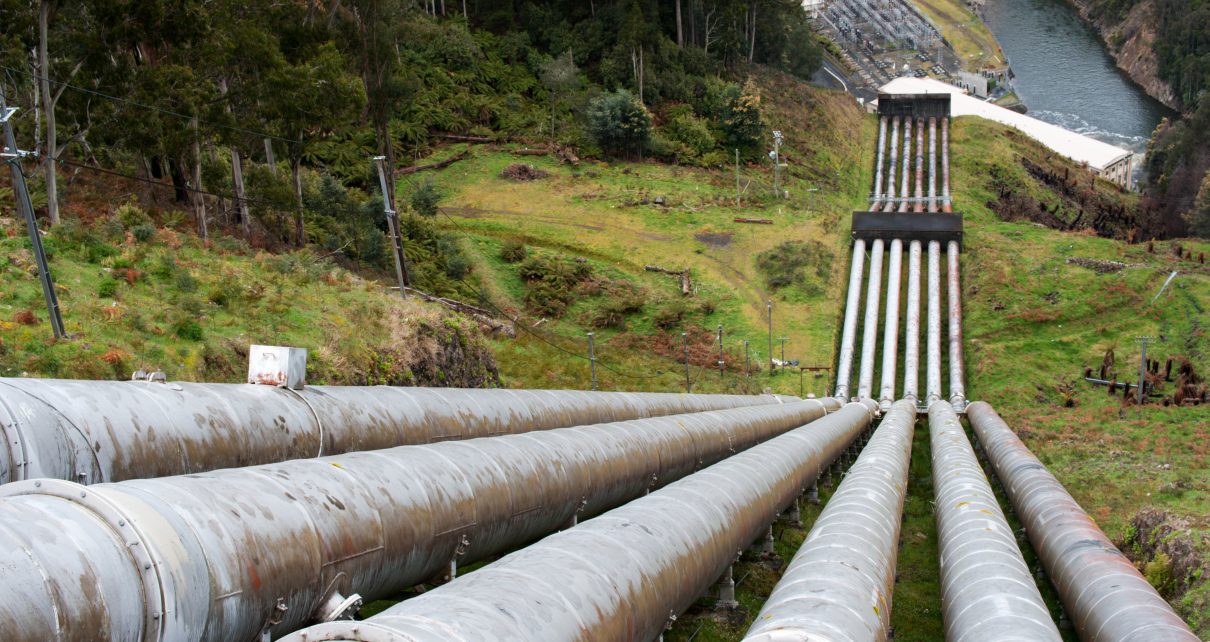Fires aided by climate change wrecked havoc last year across Australia.
Now there’s a chance that water could help save the country from an even worse fate—and not just as a way to extinguish future blazes.
An Australian utility has drawn up plans that would marry the country’s renewable energy power with a decades-old trick of hydro engineering.
If successful, the design could help solve one of the biggest hurdles of renewable energy: finding a way to store excess power generated by wind turbines and solar panels. Critically for the global fight against climate change, it also could reduce Australia’s reliance on coal.
That is, if the “Battery of the Nation” ever gets built.
The concept itself is simple—use excess renewable electricity generated during low demand cycles to pump water uphill, and then release that water downhill through turbines when electricity demand is high, to both satisfy additional demand and turn a profit. General systems involve two separate reservoirs, one of them higher in elevation, connected by pumps and a tunnel. Water is cycled back up to the higher-elevation reservoir at night, using it as a storage basin.
The technology was first put to commercial use in the 1960s. The United States, Japan and Europe have been using pumped storage hydro for decades to improve the economics of nuclear power plants, because nuclear reactors can’t be easily ramped up or scaled down depending on electricity demand. A 2013 study by the Norwegian University of Science and Technology called pumped storage hydropower “the only form of renewable energy storage that is well developed and in wide commercial use today.”
Some 130 gigawatts of installed pumped storage hydro capacity exists in the world today, a third of it in Europe. It constitutes 95% of existing utility power storage in the U.S., according to the Department of Energy.
Hydro Tasmania, the utility on Australia’s main southern island, wants to take the concept and run with it.
It wants to build a massive pumped hydro storage system that would use underutilized nighttime wind power to work the pumps and return water to higher elevations. When the winds die down, the water would be released through turbines, helping to keep the grid stable.
Christopher Gwynne, the Battery of the Nation’s program director at Hydro Tasmania, said pumped hydro storage systems such as the one he’s leading are fundamental to Australia’s broader plan for tackling climate change through phasing out high-carbon electricity generation, in particular coal-fired power plants.
“It’s the mainland states of Australia who are transitioning away from coal-fired generation and are moving very quickly to a system that’s going to be based mainly on wind and solar,” Gwynne explained. “The challenge for this transition at a national level is how do we actually get enough storage in the system to make sure that those new wind and solar resources in Victoria or South Australia or New South Wales have plenty of storage to ensure that we have a reliable and secure supply.”
Pumped storage hydro hasn’t been paired with non-hydro renewable energy at large scales, but Hydro Tasmania and other companies want to spend billions of dollars to do just that.
Hydropower is well established on Tasmania and meets the bulk of the island’s electricity needs. More wind generation is being added, and within two to three years Tasmania may become the first Australian state to achieve a completely zero-emissions electricity network, ending its need to import coal-sourced electricity from the mainland.
But Tasmania wants to go further. Via proposed new undersea power cables, additional hydropower generating capacity and a new pumped storage hydro system, planners believe the island can help other Australian states increase carbon-free wind and solar generation without risking instability to their grids.
If the vision is fulfilled, then the country would transition from a power system mainly serviced by coal to a system primarily served by wind and solar. Both the Battery of the Nation and a new undersea interconnection are needed to make it work.
“You certainly wouldn’t invest in the hydropower assets unless you knew the interconnector was coming, but the business case for the interconnector relies on the value that those investments would bring to the market,” Gwynne said. “We basically try and pick up the whole chicken-and-egg conundrum and move the whole thing forward.”
Pumped storage hydro is being pursued in lieu of more grid storage batteries because of the superior energy storage capacity. Gwynne estimates the best commercial grid battery today can be relied on for only four to six hours maximum. The pumped storage hydro system Hydro Tasmania has in mind would be available for backup energy storage for more than 12 hours.
The 2013 Norwegian study argued that a pumped storage hydro system can be used “for storing energy at multiple time horizons, ranging from hours to several years.” The systems will also last far longer than grid-connected chemical batteries. Pumped storage hydro systems can be commissioned to last 50 to 100 years.
The Battery of the Nation will be an energy megaproject.
The undersea cable portion of the system, dubbed Marinus Link, would involve adding two lines capable of moving 1,500 megawatts of additional electricity from the island to the Australian mainland.
Marinus Link is to be built by the transmission company TasNetworks at a cost of about $3 billion.
In his State of the Nation address delivered this week, Prime Minister Scott Morrison announced that the government would fast-track permitting for Marinus Link, listing the project as among his administration’s top priorities. The Australian government has already injected some $40 million to help Marinus Link sail through design and approval phases.
TasNetworks CEO Lance Balcombe hailed the prime minister’s support in a release.
“Tasmania has tremendous wind and hydro resources, as well as the potential for pumped hydro storage and hydrogen production,” Balcombe said. “The full potential can only be unlocked by building Marinus Link.”
Hydro Tasmania wants to beef up its existing hydropower infrastructure to supply the additional wattage to the Marinus Link interconnection. By building an additional higher-elevation reservoir, new turbine capacity and an underground pumping network, the company believes it can help run the entire island of Tasmania on renewable energy while exporting a huge surplus of emissions-free power to the mainland. The cost for the Battery of the Nation concept is put at roughly $1 billion.
The Battery of the Nation enjoys the full backing of the Australian and Tasmanian governments, and it’s starting to attract investor interest. It is not the only major pumped storage hydropower plan in the works in Australia.
Snowy Hydro in New South Wales is moving ahead on its Snowy 2.0 pumped storage hydro expansion project. The company plans to connect two existing reservoirs more than 15 miles apart via an underground power and pumping system, again using underutilized renewable energy to move the water uphill during periods of low electricity demand.
Snowy Hydro calls its plan “the largest committed renewable energy project in Australia” and says it would begin operations as early as 2025, ramping up from there until it achieves 2,000 MW of additional generating capacity. Snowy 2.0 may cost nearly $3 billion to build, but Snowy Hydro says it’s committed after securing $1 billion in equity from the Australian government.
More plans are expected. A 2017 study by the Australian National University concluded that the entire country could shift to 100% renewable electricity buffered by only 36 square kilometers of reservoir space, “which is a small fraction of existing artificial reservoirs,” the ANU researchers argued.
The Australian Energy Market Operator (AEMO) is busy incorporating new, large-scale pumped storage hydropower plans into the nation’s new longer-term Integrated System Plan for vastly transforming the grid via higher levels of wind and solar power generation. AEMO’s latest draft ISP is expected to be released next month.
Gwynne said the twin Battery of the Nation and Marinus Link projects would be running by the late 2020s assuming permitting goes well and financing arrives. He seemed confident the plan would proceed in earnest.
“As we get further into this transformation, I think the market is now realizing that there’s a critical role for batteries to play as they come into the technology mix,” he said.
He added that a “critical role” for pumped hydro is deep storage—the ability to store energy for longer than 12 hours.
“The further you get into these transitions and the higher level of renewables penetration you get, the longer duration of storage you need,” he said.
Reprinted from Climatewire with permission from E&E News. E&E provides daily coverage of essential energy and environmental news at www.eenews.net.


